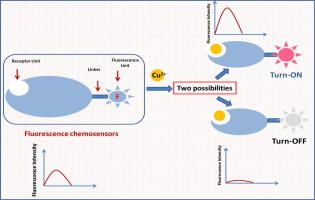Spectrochimica Acta Part A: Molecular and Biomolecular Spectroscopy ( IF 4.3 ) Pub Date : 2021-02-22 , DOI: 10.1016/j.saa.2021.119610 Shivani Sharma , Kalyan Sundar Ghosh

|
An essential trace element copper plays several physiological roles in living systems. But at excess concentration, it exerts toxicity and becomes associated with numerous disorders. In this article, we have reviewed the recent developments (from 2017 to 2020) in the field of fluorescence-based chemosensors for the detection of Cu2+ ion. The sensing probes which were built to work through transfer of photo-induced electron (PET), excited-state intramolecular proton (ESIPT) and Förster resonance energy (FRET) mechanisms have been included in this review. Emphasis is given on the design, sensitivity and response of the probe molecules for the detection of Cu2+ ion. Using suitable examples, applications of these three recognition mechanisms for the probing of copper ion have been addressed.
中文翻译:

利用荧光传感器检测铜离子的最新进展(2017-20年),该传感器通过转移光致电子(PET),激发态分子内质子(ESIPT)和福斯特共振能(FRET)进行工作
必需的微量元素铜在生命系统中起着多种生理作用。但是,如果浓度过高,它会产生毒性并与许多疾病相关。在本文中,我们回顾了用于检测Cu 2+离子的基于荧光的化学传感器领域中的最新进展(从2017年到2020年)。通过传递光致电子(PET),激发态分子内质子(ESIPT)和福斯特共振能(FRET)机制而构建的传感探针已包括在本综述中。重点介绍了用于检测Cu 2+的探针分子的设计,灵敏度和响应离子。使用合适的例子,已经解决了这三种识别机制在探测铜离子中的应用。











































 京公网安备 11010802027423号
京公网安备 11010802027423号